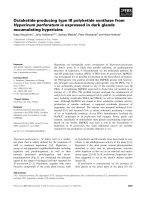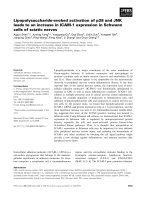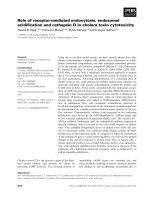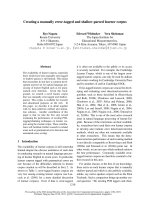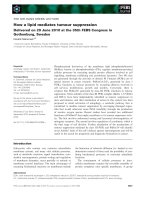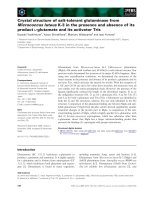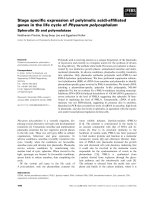báo cáo khoa học: " Creating a knowledge translation trainee collaborative: from conceptualization to lessons learned in the first year" pdf
Bạn đang xem bản rút gọn của tài liệu. Xem và tải ngay bản đầy đủ của tài liệu tại đây (218.86 KB, 5 trang )
MEETI N G REP O R T Open Access
Creating a knowledge translation trainee
collaborative: from conceptualization to lessons
learned in the first year
Evelyn Cornelissen
1*
, Robin Urquhart
2
, Vivian WY Chan
3
, Ryan T DeForge
4
, Heather L Colquhoun
5
,
Shannon Sibbald
6
and Holly Witteman
7
Abstract
Trainees (e.g., graduate students, residents, fellows) are increasingly identifying knowledge translation as their
research discipline. In Canada, a group of trainees have created a trainee-initiated and trainee-led national
collaborative to provide a vehicle for trainees to examine the diversity of knowl edge translation research and
practice, and to link trainees from diverse geographical areas and disciplines. The aim of this paper is to describe
our experience and lessons learned in creating the Knowledge Translation Trainee Collaborative. In this meeting
report, we outline the process, challenges, and opportunities in planning and experiencing the collaborative’s
inaugural meeting as participant organizers, and present outcomes and learnings to date.
Background
As the field of knowledge translation (KT) grows, trai-
nees (e.g., graduate students, residents, fellows) are iden-
tifying KT as their research discipline. The most
efficient way to advance the science of KT while devel-
oping new scholars will be to encourage new research
collaborations and partnerships [1] and expose new
researchers to multiple modes of inquiry and perspec-
tives [2].
In 2008, KT Canada, along with its funding partners,
established KT Summer Institutes (SI) to create oppor-
tunities for students involved in KT to learn from and
connect with established KT researchers and other
trainees [3]. These three- to four-day workshops have
resulted in several subsequ ent collaborative efforts,
including published papers [4,5] and successful grant
applications [6,7]. Following the 2008 SI, several trai-
nees identified a need for ongoing training and peer
networking opportunities, and accordingly set out to
create a collaborative that might serve to complement
or supplement groups led and populated by experts in
the field.
After an initial (unsuccessful) attempt to align a trai-
nee networking meeting with a national health services
research conference, two trainees [EC and VC] were
awarded a grant [6], along with funding and in-kind
support from other organizations, to hold an inaugural
meeting to build such a collaborative. Thirteen addi-
tional SI participants [including RU, RD, HC, and HW]
volu nteered to plan the event. Following a formal appli-
cation and review process supported by national KT
experts, we held a two-day meeting in Wi nnipeg, Mani-
toba, 6 and 7 March 2010.
The aim of this paper is to describe our experience
and lessons learned in creating the KT Trainee Colla-
borative (KTTC). We outline the process, challenges,
and opportunities in planning and experiencing the
KTTC inaugural meeting as participant organizers, and
present outcomes and learnings to date.
KTTC inaugural meeting
The inaugural meeting followed six month s of plann ing
via teleconference and email. The planning committee
established three meeting objectives: forming our net-
work; identifying areas for collaboration; and, with KT
experts, reviewing potential gaps and training areas in
KT research. We developed an agenda tow ard these
goals and distributed a call for applicants.
* Correspondence:
1
University of British Columbia - Okanagan, Faculty of Health and Social
Development, 3333 University Way, Kelowna, B.C. V1V 1V7 Canada
Full list of author information is available at the end of the article
Cornelissen et al. Implementation Science 2011, 6:98
/>Implementation
Science
© 2011 Corneli ssen et al; licensee BioMed Central Ltd. This is an Open Access article distributed under the terms of the Creative
Commons Attribution License (http://creativ ecommon s.org/licenses/by/2.0) , which permits unrestricted use, distribution, and
reproduction in any medium, provided the original work is properly cited.
Sixty-six applications were received from 14 Canadian
universities. The applications were peer-reviewed by a
group of planning committee member s and KT experts.
Review criteria included training, research interests,
expectations, and anticipated contribution to the meet-
ing. The aim of the review process was to assemble a
group of trainees that could both contribute to and gain
from capacity building in the field of KT. Thirty trainees
attended the meeting: 11 from the planning committee
and 19 accepted through the application process.
Table 1 describes attendee characteristics.
The meeting involved four activities, interspersed by
networking opportunities: setting the stage for future
interaction/collaborations; goal-setting; KT expert-led
discussion on potential gaps/training areas in KT
research; and post-meeting planning. Dr. Ian Graham,
Canadian Institutes of Health Research (CIHR) Vice
President of KT, participated as the overall meeting
facilitator.
Setting the stage
To begin the meeting, each attendee introduced her/
himself in a two-minute prepared talk describing her/his
research, career stage, KT interests, and something
about her/himself. These introductions oriented us to
each other’s work, provided opportunity to p ractice a
fundamental skill in scholarship (concisely describing
one’s work t o an interd isciplinary audi ence), and
ensured that all attendees participated early on.
Two planning committee members [RD, HC] then
facilitated a ‘creating space’ exercise to establish princi-
ples for interactio n and a sense of ‘safety.’ We acknowl-
edgedthatovertimeour‘space’ would likely take
different forms because it was expected that, going for-
ward, the KTTC would meet both in-person and vir-
tually. However, the focus of this exercise was to co-
construct shared principles for relating to and with one
another in t he context of this meeting. We also
acknowledged that all shared spaces are inherently char-
acterized by competing interests, agendas, needs, and
experiences. Our aim was to encourage these interests
and to conceive of new ways of working together
wherein we each feel included and valued. The facilita-
tors invited small g roups to consider quest ions about
cre ating an inclus ive and engaging workspace, then col-
lated responses to form a foundation of shared under-
standings upon which we continued our meeting.
Goal setting
To make sense of our group’s goals and expectations,
first, each attendee identified his/her individual goals.
Then, we iteratively and thematically categorized indivi -
dual goals into four collectiv e goals: networking, colla-
borative learning, collaborative wor k, and pr ofessional
development. Although it was evident that attendees
held diverse research interests in a broad range of health
areas, the four collective goals reflected our common
perspectives and desires.
Expert-led discussions
KT experts presented their perspectives and experiences
in three different areas identified as representing fruitful
are as for further research and training: behavioural the-
ory in policy/decision support (Dr. Jamie Brehaut [8]),
unintended consequences of KT (Dr. Maria Mathews
[9]), and critical/qualitative inquiry in KT (Dr. Annette
J. Browne [10]). The experts then facilitated small group
discussions based on their presentation topics.
Post-meeting planning
We ended the meeting by developing a post-meeting
plan. We brainstormed activities to help us meet our
collective goals, and elected a Steering Committee to
oversee activities and establish a governance structure.
Table 1 Attendee characteristics
Planning Committee (n = 11)
Count (percent) Number of institutions represented
[institution names]
Successful Applicants (n = 19)
Count (percent) Number of institutions represented [institution names]
Gender 1 male (9%)
10 female (91%)
5 male (26%)
14 female (74%)*
Province 1 Nova Scotia (9%) [Dalhousie University]
1 Prince Edward Island (9%) [University of Prince Edward
Island]
4 Ontario (36%) 2 universities, 1 hospital [University of
Western Ontario; McMaster University; St. Michael’s Hospital]
1 Manitoba (9%) [University of Manitoba]
1 Alberta (9%) [University of Calgary]
2 British Columbia (18%) 1 university [University of British
Columbia]
1 University of Michigan (9%)
1 Nova Scotia (5%) [Dalhousie University]
2 Quebec (11%) 2 universities [McGill University; Universite de Laval]
12 Ontario (63%) 6 universities [University of Waterloo; University of Western
Ontario; McMaster University; University of Ottawa; York University;
University of Toronto]
1 Manitoba (5%) [University of Manitoba]
2 Alberta (11%) 1 university [University of Alberta]
1 British Columbia (5%) [University of British Columbia]
Training 1 Post Doctoral/Fellows (9%)
9 Doctoral (82%)
1 Research Staff (9%)
5 Post Doctoral/Fellows (26%)
13 Doctoral (68%)
1 Master’s (5%)
*The high percentage of female participants is representative of the proportion of applicants who were female.
Cornelissen et al. Implementation Science 2011, 6:98
/>Page 2 of 5
We also reached agreement on preferred technological
mechanisms to support ongoing collaboration with lim-
ited resources.
Meeting evaluation
Using a ‘two stars and a wish’ exercise to garner feed-
back, wherein attendees were asked to list two things
about the meeti ng they enjoyed and one thing they
would like to see changed or improved, attendees indi-
cated they felt: encouraged to be engaged in the process
(’ an interactive, open, and respectful atmosphere’);
accomplished (’amazing how much we accomplished in
1.5 days’); and well-facilitated (’gr adual process ’; ‘induc-
tive approach’). Members wished for: a clearer vision
(’more concrete sense of how to collaborate immedi-
ately’) and m ore opportunities to network (’formal and
informal time’).
KTTC outcomes
From this meeting, the KTTC emerged as a uniquely
trainee-initiated and trainee-led national collaborative
to provide a vehicle for trainees to examine the diver-
sity of KT research and practice, and to link trainees
from diverse geographical areas and disciplines. We
identify as a type of c ommunity of practice (CoP) [11]
for KT trainees in Canada, with the underlying belief
that junior researchers and practitioners can acquire
valuable KT k nowledge and skills, and engage in bene-
ficial collaborative learning and working processes,
through social relationships with their peers. A recent
systematic review [12] identified four characteristics of
CoP groups that we perceive are shared by the KTTC:
members interact with one another in formal and
informal settings; members share knowledge with one
another; members c ollaborate with one another to cre-
ate new knowledge; and groups promote the d evelop-
ment of a shared, professional identity amongst
members.
To date, we have created a formal collaborative, and
opened to new membership in February 2011. We have
identity, mission, and vision statements (Table 2), a gov-
ernance structure to guide our continued growth, and
working groups to develop and implement specific activ-
ities toward our collective goals [13].
We have assembled a database of current and poten-
tial collaborators, held a second meeting in May 2010 to
coincide with a national conference [14] and a third
meeting in April 2011 funded by another peer-reviewed
grant [7], and launched a group blog hosted on a
national KT website [15]. Traditional academic outputs
include poster presentations at two academic confer-
ences [16,17] and a successful funding application for a
follow-up meeting [7]. That trainees from this collabora-
tive have received two peer-reviewed grants from a
national health research funding agency without a tradi-
tional independent investigator is a significant achieve-
ment that speaks to the commitment and initiative of
members.
Moving forward
As the meeting concluded, a number of challenges and
opportunities were identified (Table 3). In order to
respond to these challenges and opportunities, and par-
ticularly in order to maintain our momentum, attendees
decided to devote the subsequent six to twelve months
to creating a vision, governance structure, and technolo-
gical infrastructure before opening the KTTC to new
membership. As we plan the KTTC’ s future, we are
challenged by our status as trainees and concerns about
sustainability. Our commitment to the collaborative
requires creative thinking, and belief that time invested
now–in our group, career development, and collabora-
tive learning/work–will yield future benefit. S uch chal-
lenges are common in the early stages of many social
inno vati ons that eventually succeed [18], and challenge s
often coexist with opportunities.
Key Learnings
Three key learnings that may be applicable to other
groups emerged from the meeting.
First, we found the term ‘trainee’ was more conten-
tious than we had foreseen. Some members felt the
term would soon cease to apply as members began their
Table 2 Identity, mission, and vision statements
Who We
Are
The Knowledge Translation Trainee Collaborative (KTTC) is a community of practice in knowledge translation (KT). Members of the
KTTC are junior researchers and practitioners who are interested in continuing to learn about and advance the field of KT, and who
want to collaborate and build networks with other KT trainees. We define trainees as students, graduate students, postdoctoral fellows,
faculty, community learners, scientists/researchers from a wide spectrum of academia, healthcare professionals, healthcare
administrators, and/or others who are new to KT and are interested in actively exploring and developing KT research and practice.
Vision We envision a sustainable network that provides accessible, ongoing opportunities for collaboration and learning; represents diversity
of thought in KT theory, methods and tools; and grows and advances the field of KT.
Mission We are creating our vision by sharing opportunities for:
1. collaborative learning
2. collaborative work
3. building networks
4. career development
Cornelissen et al. Implementation Science 2011, 6:98
/>Page 3 of 5
careers . Others, however, saw the word as one that con-
notes life-long learning and as applica ble to KT learners
(within or outside academe) at all career stages. Even-
tually, the group adopted the latter interpretation and
clarified it in our Mission and Vision statements.
Second, as with any large group aiming for inclusivity
of all members, we encountered tension between the
desire for a ‘flat’ structure–with its potential for time-
consuming and stagnating discussions–and the inev ita-
ble hierarchy of a formal collaborative. Further, at the
meeting, open-ended questions to attendees such as,
‘How would you like to do this?’ were sometimes more
off-putting than welcomed. Ultimately, the planning
committee reconciled these issues by being transparent
about the ‘tyranny of structurelessness’ [19] and by
inviting all attendees to collectively endorse some execu-
tive decision-making and organizational structure,
grounded in our principles from the creating space
activity. Such an endorsement later empowered the
Steering Committee to make decisions required to build
the collaborative.
Third, in the same way that facilitation is important in
KT initiatives [20,21], we found it equally crucial in the
development of our collaborative. While the continua
that Harvey et al. [21] present to conceptualize facilita-
tion might be interpreted as an either/or dichotomy (i.e.,
either task-oriented, doing for others, or holistic/
enabling others), our experience was one of and/both.
As facilitators, we needed to provide some structure to
the meeting, but also needed to ensure that each activity
unfolded in a way that left all attendees feeling their
contributions were authentically valued. In other words,
and as Harvey et al. [21] postulate, effective facilitators
need to be flexible and possess a range of task-focused
and enabling skills that can be employed according to
contextual needs. We relied on tenets of empowering
dialogue [22] by f ocusing on attendees’ concerns, using
(inter)active learning strat egies, and engaging attendees
in processes to identify their needs and priorities. The
integration of task and holistic facilitation, with
empowering dialogue, helped us realize our meeting
objectives. Beyond enabling group formation, it is our
sense that strategies such as these also serve to identify
and respect unique disciplinary perspectives of group
members, which is essential in fostering a KT climate
that espouses growth from multi- to inter-discip linarity
[23]. In this way, we feel the KTTC also serves to start
addressing the challenges of cross-disciplinary
collaboration.
Conclusion
Advances in KT will necessitate multiple perspectives,
research ap proaches [2], and open c ross-pollination
amongst disciplines [24]. By bringing together a diverse
group of trainees, the trainee-led KTTC offers the
potential to complement or supplement the formal
training act ivities of expert- or mentor-led groups, such
as KT Canada, by allowing for more peer interaction
and peer leadership opportunities. Through such experi-
ences, we expect members of the collaborative to b etter
achieve the benefits of inter- and trans-disciplinarity
[23]; that is, we expect the field and our o wn individual
research products to be improved thr ough exposure to
diverse and challenging ideas in a community of KT
scholar and practitioner peers. Expanded membership
and continued commitment from KT trainees will, we
hope, produce further collaborative learning and work
experiences that can continue to contribute to the field
of KT and benefit other trainees in the field.
To learn more about membership in the KTTC, go to
/>Acknowledgements
We are grateful for the funding received from the Canadian Institutes of
Health Research (CIHR MPD grant), KT Canada and the Western Regional
Training Centre for Health Services Research (WRTC) to host our inaugural
meeting. We thank WRTC (and Dr. Sam Sheps) and the CIHR Institute for
Health Services and Policy Research (IHSPR) (and Ms. Meg McMahon) for in-
kind support of our meeting, KT Canada and the Knowledge Translation
Program at Li Ka Shing Knowledge Institute of St. Michael’s, University of
Toronto for hosting our blog, and Dr. Sharon Straus for her mentorship. We
thank Ms. Isabella Losinger, WRTC manager, for her administrative support
Table 3 Challenges and opportunities identified during and after the inaugural meeting
Challenges Opportunities
▪ Ensuring the KTTC achieves diversity (e.g., in research methodologies, disciplines,
geography, and academic vs. practice environments)
▪ Maintaining momentum
▪ Ensuring active and effective external and internal communication
▪ Providing value for all members (e.g., senior and junior)
▪ Meeting the expectations of all active members
▪ Workload for members involved in administration
▪ Growing academic and administrative interest in KT
▪ Increasing number of KT trainees across Canada*
▪ Committed membership comprised of trainees from
diverse backgrounds and experiences
▪ Members who value innovative thinking on and
approaches to KT
▪ A ‘safer’ space for trainee dialogue and discourse
▪ Ability to complement and network with existing KT
research groups and agencies
*The increasing number of KT trainees is reflected by the growing number of trainee awards and opportunities in Canada: e.g., the Cana dian Institutes of Health
Research (CIHR) now provid es doctoral research awards and new investigator awards focused on KT science and KT Canada holds a Strategic Training Initiative in
Health Research grant from CIHR to create an internationally-recognized national training initiative to train graduate and post-doctoral students in KT and KT
science.
Cornelissen et al. Implementation Science 2011, 6:98
/>Page 4 of 5
with managing the meeting logistics and budget. We thank Dr. Ian Graham,
Dr. Jamie Brehaut, Dr. Maria Mathews, and Dr. Annette J. Browne for
participating in our meeting. Evelyn Cornelissen and Vivian Chan were
funded by the WRTC. Robin Urquhart is funded by the CIHR/CCNS Team in
Access to Colorectal Cancer Services in Nova Scotia and the Nova Scotia
Health Research Foundation. Ryan DeForge is funded through a CIHR
Frederick Banting - Charles Best Canada Graduate Scholarship - Doctoral
Research Award. Heather Colquhoun is funded through a CIHR Strategic
Training Fellowship in Rehabilitation Research, a CIHR Doctoral Scholarship,
and the Canadian Occupational Therapy Foundation. Shannon Sibbald is a
Canadian Health Services Research Foundation post-doctoral fellow based at
the University of Western Ontario. Holly Witteman holds a post-doctoral
fellowship at the University of Michigan funded by grants from the U. S.
National Institutes of Health (R01 CA087595 and P50 CA101451).
Author details
1
University of British Columbia - Okanagan, Faculty of Health and Social
Development, 3333 University Way, Kelowna, B.C. V1V 1V7 Canada.
2
Dalhousie University, Interdisciplinary PhD Program, 1276 South Park Street;
Room 804, Victoria Building; Halifax, N.S. B3H 2Y9 Canada.
3
University of
British Columbia, Interdisciplinary Studies Graduate Program, Green College.
Green Commons, Room 153A, 6201 Cecil Green Park Rd; Vancouver, B.C. V6T
1Z1 Canada.
4
The University of Western Ontario, Faculty of Health Sciences,
1151 Richmond St; London, O.N., N6A 5B9 Canada.
5
McMaster University,
School of Rehabilitation Sciences, IAHS Building; 1400 Main St. W.; Hamilton,
O.N., L8S 1C7 Canada.
6
University of Western Ontario, Faculties of Health
Sciences and Information and Media Studies, 1151 Richmond St; London, O.
N., N6A 5B9 Canada.
7
University of Michigan, Center for Bioethics and Social
Science in Medicine, 300 North Ingalls Building 7C27, Ann Arbor, M.I. 48109-
5429 USA.
Authors’ contributions
EC developed the outline of the paper, coordinated the content from all
authors, and prepared the first draft with assistance from RU and HW. All
authors contributed to the final content. EC, RU, VC, and HW edited the final
draft. EC, RD, HW, RU, and HC revised the manuscript according to
reviewers’ comments. All authors have read and approved the final
manuscript.
Competing interests
The authors declare that they have no competing interests.
Received: 28 January 2011 Accepted: 25 August 2011
Published: 25 August 2011
References
1. Graham I, Tetroe J: Whither Knowledge Translation: An International
Research Agenda. Nursing Research 2007, 56(4 Suppl):S7-S23.
2. Kitson A: The need for systems change: reflections on knowledge
translation and organizational change. Journal of Advanced Nursing 2009,
65(1):217-228.
3. KT Canada. [ />retrieved Nov. 2, 2010.
4. Kho M, Estey E, DeForge R, Mak L, Bell B: Riding the knowledge
translation roundabout: lessons learned from the Canadian Institutes of
Health Research Summer Institute in knowledge translation.
Implementation Science 2009, 4(33).
5. Leung B, Catallo C, Riediger N, Cahill N, Kastner M: The trainees’
perspective on developing an end-of-grant knowledge translation plan.
Implementation Science 2010, 5(1):78.
6. Chan V, Cornelissen E: Developing a Student Community of Practice in
KT Research. CIHR Meetings, Planning, Dissemination Grant - Knowledge
Translation competition 2009, [awarded] $15,000 CAD.
7. Cornelissen E, Urquhart R, Colquhoun H, DeForge R, Emberly D,
Richmond S, Witteman H: Towards planning a sustainable knowledge
translation trainee collaborative. CIHR Meetings, Planning, Dissemination
Grant - Planning Grants, Spring 2010 competition , [awarded] $25, 000 CAD.
8. Dr. Jamie Brehaut. [ retrieved Jan.
12, 2011.
9. Dr. Maria Matthews. [ />Maria.aspx], retrieved Jan. 12, 2011.
10. Dr. Annette J. Browne. [ />c=70.8731260775197], retrieved Jan. 12, 2011.
11. Wenger E, McDermott RA, Snyder W: Cultivating Communities of Practice
Boston, MA: Harvard Business School Press; 2002.
12. Li LC, Grimshaw JM, Nielsen C, Judd M, Coyte PC, Graham ID: Use of
communities of practice in business and health care sectors: a
systematic review. Implementation Science 2009, 4(27).
13. KT Trainee Collaborative terms of reference. [ />kttc/about/], retrieved Jan. 18, 2011.
14. Canadian Association for Health Services and Policy Research annual
conference. [ retrieved Jan. 18, 2011.
15. KT Trainee Collaborative. [ retrieved Jan. 18,
2011.
16. Colquhoun H, Chan V, Cornelissen E, Urquhart R: A knowledge translation
trainee collaborative. Knowledge Translation 2010: Improving Health Care
and Health Systems with Knowledge Translation 2010, Halifax, Nova Scotia,
(poster).
17. Urquhart R, Chan V, Cornelissen E, Colquhoun H: Development of a
national knowledge translation trainee collaborative towards advancing
the field of knowledge translation in Canada. Family Medicine Forum 2010
2010, Vancouver, (poster).
18. Westley F, Zimmerman B, Patton MQ: Getting to maybe: how the world is
changed Toronto: Vintage Canada, Random House of Canada Limited; 2007.
19. Freeman J: The tyranny of structurelessness. Berkeley Journal of Sociology
1972, 17
:151-165.
20. Kitson A, Harvey G, McCormack B: Enabling the implementation of
evidence based practice: A conceptual framework. Quality in Health Care
1998, 7(3):149-158.
21. Harvey G, Loftus-Hills A, Rycroft-Malone J, Titchen A, Kitson A,
McCormack B, et al: Getting evidence into practice: The role and function
of facilitation. Journal of Advanced Nursing 2002, 37(6):577-588.
22. Freiré P: Education for Critical Consciousness New York: Continuum; 1973.
23. Choi BCK, Pak AWP: Multidisciplinarity, interdisciplinarity and
transdisciplinarity in health research, services, education and policy: 1.
Definitions, objectives, and evidence of effectiveness. Clinical and
Investigative Medicine 2006, 29(6):351-364.
24. Lather L: Paradigm proliferation as a good thing to think with: teaching
research in education as a wild profusion. International Journal of
Qualitative Studies in Education 2006, 19(1):35-57.
doi:10.1186/1748-5908-6-98
Cite this article as: Cornelissen et al.: Creating a knowledge translation
trainee collaborative: from conceptualization to lessons learned in the
first year. Implementation Science 2011 6:98.
Submit your next manuscript to BioMed Central
and take full advantage of:
• Convenient online submission
• Thorough peer review
• No space constraints or color figure charges
• Immediate publication on acceptance
• Inclusion in PubMed, CAS, Scopus and Google Scholar
• Research which is freely available for redistribution
Submit your manuscript at
www.biomedcentral.com/submit
Cornelissen et al. Implementation Science 2011, 6:98
/>Page 5 of 5


